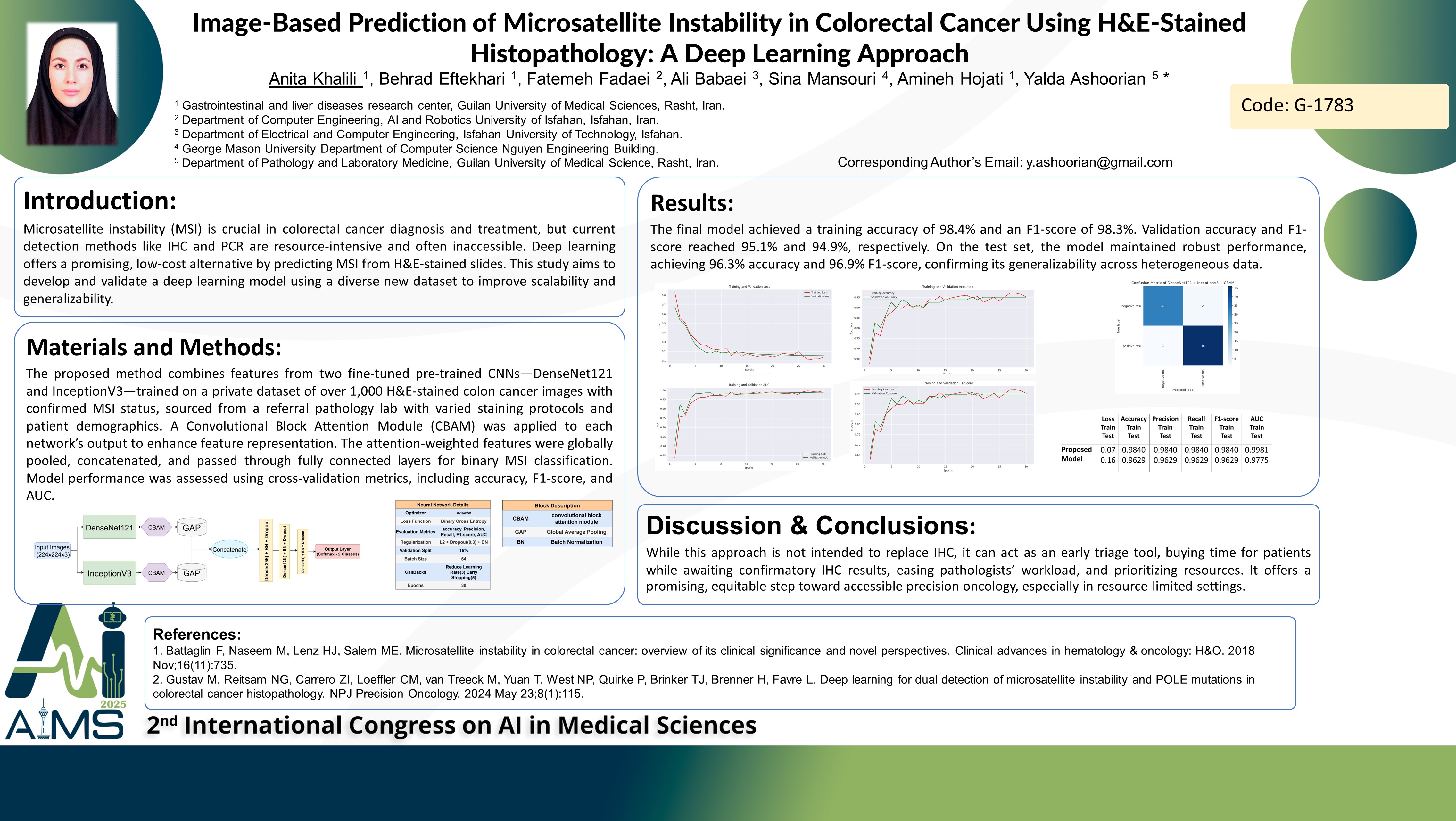پیشبینی ناپایداری میکروساتلایت در سرطان کولورکتال بر اساس تصاویر بافتشناسی رنگآمیزیشده با هماتوکسیلین-ائوزین: یک رویکرد یادگیری عمیق دو مسیره
کد: G-1783
نویسندگان: Anita Khalili ℗, Behrad Eftekhari, Fatemeh Fadaei, Ali Babaei, Sina Mansouri, Amineh Hojati, Yalda Ashoorian *
زمان بندی: زمان بندی نشده!
برچسب: پردازش تصاویر پزشکی
دانلود: دانلود پوستر
خلاصه مقاله:
خلاصه مقاله
Background and Aim: Microsatellite instability (MSI) is a key molecular biomarker in colorectal cancer, critical for identifying patients eligible for immunotherapy and screening hereditary cancer syndromes such as Lynch syndrome. Current gold-standard MSI detection methods—immunohistochemistry (IHC) and PCR—are accurate but often time-consuming, resource-intensive, and inaccessible in low-resource settings due to their dependence on specialized laboratory infrastructure and expertise. These constraints hinder routine MSI screening in many clinical environments. Recently, deep learning has emerged as a promising non-invasive alternative, with growing evidence supporting the feasibility of predicting MSI status from routine hematoxylin and eosin (H&E) stained slides. However, the lack of publicly available datasets with matched MSI labels and the homogeneity of prior studies limit model generalizability. This study aims to develop and validate a dual-path deep learning model for MSI prediction using a novel, diverse dataset of H&E-stained colorectal cancer images, offering a scalable, low-cost adjunct to molecular testing. Method: Our proposed dual-path deep learning method integrates features from two pre-trained convolutional neural networks—DenseNet121 and InceptionV3—fine-tuned on a private dataset comprising over 500 digitized H&E-stained colon cancer images with confirmed MSI status. We collected data from a referral pathology laboratory with diverse staining protocols and patient demographics. To enhance feature representation, we applied a Convolutional Block Attention Module (CBAM) to the outputs of each path. The attention-weighted features from both paths were globally pooled, concatenated, and passed through fully connected layers for final binary classification. Model performance was evaluated using cross-validation metrics such as accuracy, F1-score, and AUC. Results: The final model achieved a training accuracy of 98.4% and an F1-score of 98.3%. Validation accuracy and F1-score reached 95.1% and 94.9%, respectively. On the test set, the model maintained robust performance, achieving 96.3% accuracy and 96.9% F1-score, confirming its generalizability across heterogeneous data. Conclusion: While this approach is not intended to replace IHC, it can act as an early triage tool, buying time for patients while awaiting confirmatory IHC results, easing pathologists’ workload, and prioritizing resources. It offers a promising, equitable step toward accessible precision oncology, especially in resource-limited settings.
کلمات کلیدی
Microsatellite Instability, Colorectal Cancer, Deep Learning
